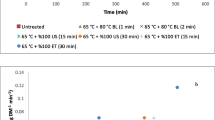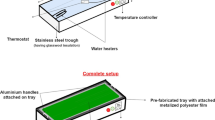Abstract
In this paper, multi-stage continuous belt (MSCB) dryer was used for carrot slices drying. Experiments were performed at three air speeds (1, 1.5, and 2 m/s) three belt linear velocities (2.5, 6.5, and 10.5 mm/s), and three air temperatures (40, 55, and 70 °C) in triplicate. Three intelligent systems including Ant-Lion-Optimizer (ALO), Grey-Wolf-Optimizer (GWO) and Whale-Optimization-Algorithm (WOA) models were developed to predict the thermodynamic properties of carrot slices including of effective moisture diffusivity (Deff) and specific energy consumption (SEC). The results revealed that Deff and SEC values were in the range of 1.77–2.90 × 10−9 m2/s and 169.77–551.19 MJ/kg, respectively. The models of ALO, GWO, and WOA were able to predict the value of Deff and SEC. The amounts of correlation coefficient (\(R\)), root-mean-square error (\({\text{RMSE}}\)), and mean absolute error (\({\text{MAE}}\)) for ALO, GWO, and WOA models for predication Deff were obtained (0.9989, 7.81 × 10−12, and 1.50 × 10−12), (0.9993, 5.39 × 10−12, and 1.03 × 10−12) and (0.9994, 4.95 × 10−12, and 9.54 × 10−13), respectively. In addition, The amounts of \(R\), \({\text{RMSE}}\), and \({\text{MAE}}\) for ALO, GWO, and WOA model for predication SEC were obtained (0.9983, 0.6700, and 0.1289), (0.9988, 0.5274, and 0.0715) and (0.9996, 0.2566, and 0.0060), respectively. Therefore, model of WOA can be used to easily and accurately predict Deff and SEC values.









Similar content being viewed by others
References
Demiray E, Tulek Y (2015) Color degradation kinetics of carrot (Daucus carota L.) slices during hot air drying. J Food Process Preserv 39:800–805
Movahhed MK, Mohebbi M (2016) Spray drying and process optimization of carrot–celery juice. J Food Process Preserv 40:212–225
Zielinska M, Markowski M (2010) Air drying characteristics and moisture diffusivity of carrots. Chem Eng Process 49:212–218
Calin-Sanchez A, Figiel A, Hernandez F, Melgarejo P, Lech K, Carbonell-Barrachina AA (2013) Chemical composition, antiox-idant capacity, and sensory quality of pomegranate (Punica granatum L.) arils and rind as affected by drying method. Food Bioprosess Technol 6:1644–1654
Horuz E, Maskan M (2015) Hot air and microwave drying of pomegranate (Punica granatum L.) arils. J Food Sci Technol 52:285–293
Aktas M, Khanlari A, Amini A, Sevik S (2017) Performance analysis of heat pump and infrared–heat pump drying of grated carrot using energy-exergy methodology. Energy Convers Manage 132:327–338
Pu H, Li Z, Hui J, Raghavan GSV (2016) Effect of relative humidity on microwave drying of carrot. J Food Eng 190:167–175
Sonmete MS, Mengeş HO, Ertekin C, Özcan MM (2017) Mathematical modeling of thin layer drying of carrot slices by forced convection. Food Meas 11(2):629–638
Nazghelichi T, Kianmehr MH, Aghbashlo M (2011) Prediction of carrot cubes drying kineticsduring fluidized bed drying by artificial neural network. J Food Sci Technol 48(5):542–550
Kaveh M, Amiri Chayjan R (2017) Modeling thin-layer drying of turnip slices under semi-industrial continuous band dryer. J Food Process Preserv 41:e12778
Perez-Alonso C, Cruz-Olivares J, Ramirez A, Roman- Guerrero A, Vernon-Carter EJ (2011) Moisture diffusion in allspice (Pimenta dioica L. Merril) fruits during fluidized bed drying. J Food Process Preserv 35:308–312
Motevali A, Minaei S, Khoshtagaza MH (2011) Evaluation of energy consumption in different drying methods. Energy Convers Manage 52:1192–1199
Motevali A, Minaei S, Khoshtaghaza MH, Amirnejat H (2011) Comparison of energy consumption and specific energy requirements of different methods for drying mushroom slices. Energy 36:6433–6441
Motevali A, Minaei S, Banakar A, Ghobadian B, Khoshtaghaza MH (2014) Comparison of energy parameters in various dryers. Energy Convers Manage 87:711–725
Basser H, Karami H, Shamshirband S, Akib S, Amirmojahedi M, Ahmad R, Jahangirzadeh A, Javidnia H (2015) Hybrid ANFIS–PSO approach for predicting optimum parameters of a protective spur dike. Appl Soft Comput 30:642–649
Mirjalili S, Mirjalili SM, Lewis A (2014) Grey wolf optimizer. Adv Eng Softw 69:46–61
Amirsadri S, Mousavirad SJ, Ebrahimpour-Komleh H (2017) A Levy flight-based grey wolf optimizer combined with backpropagation algorithm for neural network training. Neural Comput Appl Doi. https://doi.org/10.1007/s00521-00017-02952-00525
Khalilpourazari S, Khalilpourazary S (2016) Optimization of production time in the multi-pass milling process via a robust grey wolf optimizer. Neural Comput Appl Doi. https://doi.org/10.1007/s00521-00016-02644-00526
Mirjalili S (2015) The ant lion optimizer. Adv Eng Softw 83:80–98
Mirjalili S, Lewis A (2016) The whale optimization algorithm. Adv Eng Softw 95:51–67
Erenturk S, Erenturk K (2007) Comparison of genetic algorithm and neural network approachesfor the drying process of carrot. J Food Eng 78:905–912
Aghbashlo M, Kianmehr MH, Nazghelichi T, Rafiee S (2011) Optimization of an artificial neural network topology for predicting drying kinetics of carrot cubes using combined response surface and genetic algorithm. Drying Technol 29:770–779, 2011
Sahin AS (2012) Optimization of solar air collector using genetic algorithm and artificial bee colony algorithm. Heat Mass Transf 48(11):1921–1928
Chakraborty S, Sarma M, Bora J, Faisal S, Hazarika MK (2016) Generalization of drying kinetics during thin layer drying of paddy. AgricEngInt: CIGR J 18(4):177–189
Safary M, Amiri Chayjan R (2016) Optimization of almond kernels drying under infraredvacuum Condition with Microwave Pretreatment using Response Surface Method and Genetic algorithm. J Agr Sci Tech (2016) 18:1543–1556
Chen Q, Bi J, Chen R, Liu X, Wu X, Zhou M (2017) Comparative study on drying characteristic, moisture diffusivity, and some physical and nutritional attributes of blanched carrot slices. J Food Process Preserv 41(5):e13201
Kara C, Doymaz I (2015) Effective moisture diffusivity determination and mathematical modelling of drying curves of apple pomace. Heat Mass Transf 51:983–989
Celen S, Aktas T, Karabeyoglu SS, Akyildiz A (2016) Drying behavior of prina (crude olive cake) using different types of dryers. Drying Technol 34:843–853
Delgado T, Pereira JA, Baptista P, Casel S, Ramahhosa E (2014) Shell’s influence on drying kinetics, color and volumetric shrinkage of Castanea sativa Mill. Fruits. Food Res Int 55:426–435
Doymaz I (2017) Drying kinetics, rehydration and colour characteristics of convective hot- air drying of carrot slice. Heat Mass Transf 53:25–35
Tekin ZH, Başlar M, Karasu S, Kilicli M (2017) Dehydration of green beans using ultrasound assisted vacuum drying as a novel technique: drying kinetics and quality parameters. J Food Process Preserv 41(6):e13227
Aghbashlo M, Kianmehr MH, Arabhosseini A (2010) Modeling of thin-layer drying of apple slices in a semi-industrial continuous band dryer. Int J Food Eng 6:1–15
Aghbashlo M, Kianmehr MH, Arabhosseini A (2009) Modeling of thin-layer drying of potato slices in length of continuous band dryer. Energy Convers Manage 50:1348–1355
Motevali A, Jafari S, Hashemi A (2018) Effect of IR intensity and air temperature on exergy and energy at hybrid infrared-hot air dryer. Chem Ind Chem Eng Q 24(1):31–42
Kamboj VK, Bhadoria A, Bath SK (2017) Solution of non-convex economic load dispatch problem for small-scale power systems using ant lion optimizer. Neural Comput Appl 28(8):2181–2192
Medjahed SA, Saadi TA, Benyettou A, Ouali M (2016) Gray wolf optimizer for hyperspectral band selection. Appl Soft Comput 40:178–186
Kaveh A, Zakian P (2018) Improved GWO algorithm for optimal design of truss structures. Eng Comput. https://doi.org/10.1007/s00366-017-0567-1
Sulaiman MH, Mustaffa Z, Mohamed MR, Aliman O (2015) Using the gray wolf optimizer for solving optimal reactive power dispatch problem. Appl Soft Comput 32:286–292
Raju M, Saikia LC, Sinha N (2016) Automatic generation control of a multi-area system using ant lion optimizer algorithm based PID plus second order derivative controller. Inter J Electr Power Energy Syst 80:52–63
Rajan A, Jeevan K, Malakar T (2017) Weighted elitism based ant lion optimizer to solve optimum VAr planning problem. Appl Soft Comput 55:352–370
Yao P, Wang H (2017) Dynamic adaptive ant lion optimizer applied to route planning for unmanned aerial vehicle. Soft Comput 21:5475–5488
Subhashini KR, Satapathy JK (2017) Development of an enhanced ant lion optimization algorithm and its application in antenna array synthesis. Appl Soft Comput 59:153–173
Mostafa A, Hassanien AE, Houseni M, Hefny H (2017) Liver segmentation in MRI images based on whale optimization algorithm. Multimedia Tool Appl 76(23):24931–24954
Ladumor D, Trivedi IN, Jangir P, Kumar A (2016) A Whale optimization algorithm approach for unit commitment problem solution. Conference: AEPEE-2016, at Morbi. https://doi.org/10.13140/RG.2.1.1290
Aljarah I, Faris H, Mirjalili S (2018) Optimizing connection weights in neural networks using the whale optimization algorithm. Soft Comput 22(1):1–15
Hasanipanah M, Armaghani DJ, Khamesi H, Amnieh HB, Ghoraba S (2016) Several non-linear models in estimating air-overpressure resulting from mine blasting. Eng Comput 32:441–455
Tian H, Shu J, Han L (2018) The effect of ICA and PSO on ANN results in approximating elasticity modulus of rock material. Eng Comput. https://doi.org/10.1007/s00366-018-0600-z
Ghasemi E (2017) Particle swarm optimization approach for forecasting backbreak induced by bench blasting. Neural Comput Appl 28:1855–1862
Kaveh M, Amiri Chayjan R, Nikbakht AM (2017) Mass transfer characteristics of eggplant slices during length of continuous band dryer. Heat Mass Transf 53(6):2045–2059
Hasanipanah M, NoorianBidgoli M, Armaghani DJ, Khamesi H (2016) Feasibility of PSOANN model for predicting surface settlement caused by tunneling. Eng Comput 32(4):705–715
Kayran S, Doymaz I (2017) Determination of drying kinetics and physicochemical characterization of apricot pomace in hot-air dryer. J Therm Anal Calorim 130:1163–1170
Aghbashlo M, Kianmehr MH, Arabhosseini A, Nazghelichi T (2011) Modelling the carrot thin-layer drying in a semi-industrial continuous band dryer. Czech J Food Sci 29:528–538
Jafari H, Kalantari D, Azadbakht M (2017) Semi-industrial continuous band microwave dryer for energy and exergy analyses, mathematical modeling of paddy drying and it’s qualitative. Energy 138:1016–1029
Aydogdu A, Sumnu G, Sahin S (2015) Effects of microwave-infrared combination drying on quality of eggplants. Food Bioprocess Technol 8(6):1198–1210
Onwude DI, Hashim N, Abdan K, Janius R, Chen G (2018) Modelling the mid-infrared drying of sweet potato: kinetics, mass and heat transfer parameters, and energy consumption. Heat Mass Transf. https://doi.org/10.1007/s00231-018-2338-y
Onwude DI, Hashim N, Abdan K, Janius R, Chen G (2018) Investigating the influence of novel drying methods on sweet potato (Ipomoea batatas L.): kinetics, energy consumption, color, and microstructure. J Food Process Eng. https://doi.org/10.1111/jfpe.12686
Junqueira JRJ, Correa JLG, Ernesto DB (2017) Microwave, convective, and intermittentmicrowave–convective drying of pulsed vacuum osmodehydrated pumpkin slices. J Food Process Preserv 41(6):e 13250
Kaveh M, Abbaspour-Gilandeh Y, Amiri Chayjan R, Taghinezhad E, Mohammadigol R (2018) Mass transfer, physical, and mechanical characteristics of terebinth fruit (Pistacia atlantica L.) under convective infrared microwave drying. Heat Mass Transf 54(7):1879–1899
Salarikia A, Ashtiani SHM, Golzarian MR (2017) Comparison of drying characteristics and quality of peppermint leaves using different drying methods. J Food Process Preserv 41(3):e12930
Motevali A, Tabatabaei SR (2017) A comparison between pollutants and greenhouse gas emissions from operation of different dryers based on energy consumption of power plants. J Clean Prod 154:445–461
Khanali M, Banisharif A, Rafiee S (2016) Modeling of moisture diffusivity, activation energy and energy consumption in fluidized bed drying of rough rice. Heat Mass Transf 52(11):2541–2549
Das I, Arora A (2018) Alternate microwave and convective hot air application for rapid mushroom drying. J Food Eng 223:208–219
Author information
Authors and Affiliations
Corresponding author
Additional information
Publisher’s Note
Springer Nature remains neutral with regard to jurisdictional claims in published maps and institutional affiliations.
Rights and permissions
About this article
Cite this article
Kaveh, M., Amiri Chayjan, R., Taghinezhad, E. et al. Modeling of thermodynamic properties of carrot product using ALO, GWO, and WOA algorithms under multi-stage semi-industrial continuous belt dryer. Engineering with Computers 35, 1045–1058 (2019). https://doi.org/10.1007/s00366-018-0650-2
Received:
Accepted:
Published:
Issue Date:
DOI: https://doi.org/10.1007/s00366-018-0650-2




